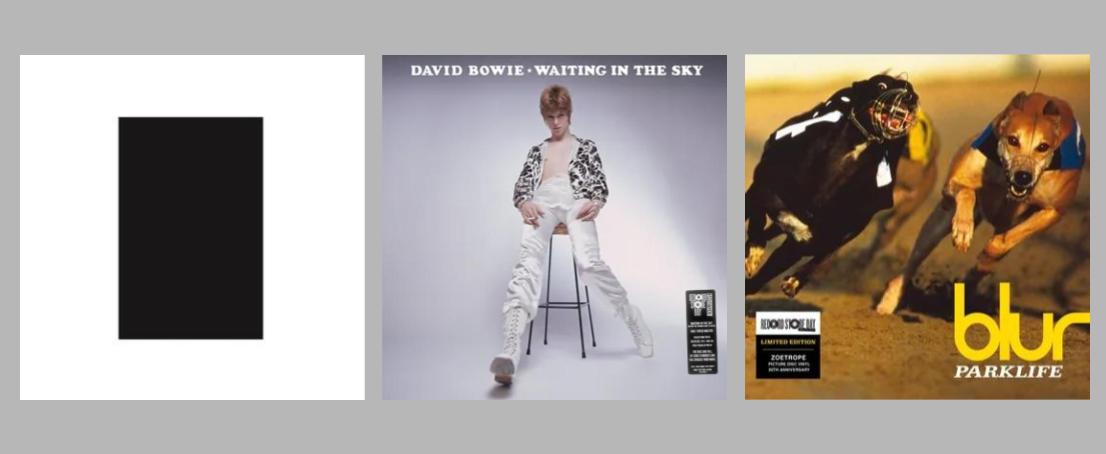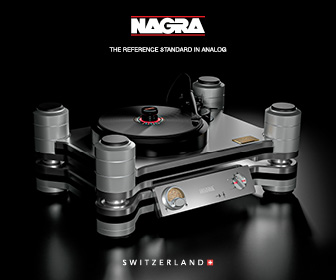Three Selections From Record Store Day 2024
Releases from David Bowie, Blur, and The 1975
While I’ve attended Record Store Day since 2014 (!), this was the first year since 2020 that I actually lined up. The lists in 2021 and 2022 were rather boring, and the main release I wanted last year was so heavily allocated in the US that I would’ve had to camp overnight. And really, are any newly manufactured records worth camping overnight for? I don't think so.
Though this year’s UK RSD list is superior to the US list (I secured online and will soon review those Nine Horses, Pulp, and Scott Walker LPs that weren’t on the US list), some overlapping selections caught my eye. So at 6:30 AM on April 20th, I stumbled down to my nearest record store, Portland’s Exiled Records. Early as that might sound, approximately 150 people were already queued. Shop owner Brian teased me for being late, though thankfully the most limited release on my wantlist (a half-speed mastered zoetrope picture disc of Blur’s Parklife) was still there when I finally got in. Unlike some past RSDs I’ve been to at other stores, Exiled’s system was orderly; as you walked through the store, the employees handed out your requested records from their blocked-off corner. This prevents impulse buying RSD items that others might want more, and ensures that there aren't 20 people crowding around three bins (which I've seen at other RSD-participating stores).
What follows are reviews of the three albums I got that morning: an early draft of David Bowie's The Rise And Fall Of Ziggy Stardust And The Spiders From Mars, the aforementioned Parklife reissue, and a live album by The 1975. For info about other RSD 2024 releases, check out Michael Fremer’s jazz roundup (plus his report on the Sonny Rollins box set) and Evan Toth’s articles about the Bernie Worrell and Nat “King” Cole releases.
David Bowie - Waiting In The Sky (Before The Starman Came To Earth)

Parlophone DBRNRSLP 722/5054197604454 half-speed mastered 180g LP
Produced by: David Bowie and Ken Scott (original recordings)
Engineered by: Ken Scott
Mixed by: Ken Scott
Mastered by: John Webber at AIR Mastering
Lacquer cut by: John Webber at AIR Mastering
Music: 8
Sound: 7
As far as David Bowie RSD cash grabs, Waiting In The Sky is certainly among the more creative ones. Like the Bowie Now! promo compilation reissued for RSD 2018 or the 40th anniversary 7” picture disc series that ran throughout the 2010s, Waiting In The Sky offers literally nothing new. Except, as Parlophone would argue, it’s the first way to properly hear The Rise And Fall Of Ziggy Stardust And The Spiders From Mars in its originally proposed form. This initial draft, generally known as Round And Round, was what Bowie submitted to RCA in late 1971 or early 1972 (the tapes are dated November 1971), until the label complained about the lack of an obvious single. Bowie then wrote “Starman,” rearranged the album’s running order, and the rest is history. The verbosely-named Waiting In The Sky (Before The Starman Came To Earth) marks the first vinyl release of the Round And Round running order, sourced from the November ’71 tapes.
The most significant deviation from the final album is the four songs that Bowie later omitted: “Holy Holy” (the later Spiders From Mars recording, not the original single version), “Velvet Goldmine,” a cover of Chuck Berry’s “Round And Round,” and a translated cover of Jacques Brel’s “Amsterdam.” All would become non-album singles or B-sides within the next few years. Missing here but included on the actual Ziggy Stardust are “It Ain’t Easy” (already recorded and even included on the famed Mainman promo LP, reissued for RSD 2017), “Starman” (not yet written), “Suffragette City,” and “Rock And Roll Suicide.”
More than anything, this early tracklist reveals how much those four songs shaped the final record. Those songs, with the exception of the comparatively negligible “It Ain’t Easy,” gave Ziggy Stardust its core structure, tying up its narrative and making the record feel important. Meanwhile, the Waiting In The Sky tracklist feels meandering. The songs all range from very good to absolutely great, but they feel lesser than the sum of their parts.
Still, Bowie’s original sequencing idea wasn’t too far off. On the November 1971 tapes, he already had the opening run of “Five Years,” “Soul Love,” and “Moonage Daydream;” keeping it that way was best. Then the momentum screeches to a confusing halt with those “Round And Round” and “Amsterdam” covers, but maybe I hear it that way because I’m so accustomed to the final running order with “Starman” and “It Ain’t Easy.”
Side two is particularly anticlimactic, opening with “Hang On To Yourself,” jumping to “Ziggy Stardust,” then throwing in “Velvet Goldmine” and “Holy Holy.” Good songs, one of which might’ve made a better side one closer than “It Ain’t Easy” on the final album, though leaving them off was a sensible choice. Most jarring on Waiting In The Sky is how it ends with “Star” and “Lady Stardust;” it’s very obviously a rough draft with an appropriately inconclusive finish.
All of these songs use the same mixes found everywhere else, and while it’s an interesting alternate context for them, is it worth its own release? Not really. The prices on the secondary market—over double the original $25 price—makes it especially easy to skip.
John Webber at AIR half-speed mastered the LP from 192kHz transfers of the Dolby’d 15ips November 1971 reels. The difference in tape generations between these tapes and the actual The Rise And Fall… masters is unclear, but what is clear is that compared to Ray Staff’s 40th anniversary cut of the actual album (possibly from tape, or a really great digital cut), this RSD release is excessively compressed. Everything’s been warmed up and dulled: transients aren’t nearly as sharp or delicate, bass is thicker and more sluggish, and images are drier and flatter. Bowie’s voice is pulled forward compared to the 40th anniversary Ziggy, where it carves out its own distinct space deeper in the soundstage. Waiting In The Sky isn’t the most disastrous Bowie reissue mastering, but it’s too smooth and boring to listen to. For the non-album tracks, the source seems better than whatever the Five Years box set’s Re:Call 1 compilation used, but snare drum snap and electric guitar excitement just isn’t there.
The packaging is bare bones but fine: a glossy, minimally designed foldover jacket with a printed inner sleeve featuring tape box scans. There should’ve been an insert explaining the significance of this early tracklist, but there’s nothing; for that, you’ll probably have to get the big Rock ’N’ Roll Star CD/BD box set in a couple months. You get what you pay for here, but that doesn’t mean you shouldn’t expect more.
Blur - Parklife

Parlophone 5054197880988 half-speed mastered picture disc LP
Produced by: Stephen Street
Engineered by: John Smith
Mixed by: Uncredited
Mastered by: Frank Arkwright at Abbey Road
Lacquer cut by: Matt Colton at Metropolis
Music: 9
Sound: 7
No one needed this 30th anniversary zoetrope picture disc reissue of Blur’s iconic Parklife, but curiosity urged me to check it out. It’s a new half-speed single LP cut! On a trendy zoetrope picture disc!
Zoetrope picture discs are the big gimmick now, yet the appeal mystifies me. Sure, it looks cool when you hold it (as all picture discs should but often don’t), but you need your phone camera (30fps for best results) and a flashlight to get the images to move properly. Even then, it’s not perfect, and it absolutely defeats the purpose of a “concentrated” listening experience. I don’t buy records so I can stare at them while they’re on my turntable. The picture disc element is no longer a significant issue, as they’ve gotten much better lately. There’s still the low-level hiss, but I have picture discs that are less crackly than their equivalent normal LPs!
The album is 52 minutes long, which is pushing it for a single LP but still short for a double LP. I already have the original UK single LP, cut DMM at Townhouse almost certainly from a CD master, as well as the 2012 double LP reissue cut from 96kHz/24bit remasters by Frank Arkwright. The 2012 has every advantage over the single LP issues, which each have their pros and cons: the original was DMM (helpful for long sides) but from a lesser source, while the RSD picture disc cut by Matt Colton at Metropolis was presumably from the 2012 files and half-speed mastered to lacquer.
The UK original has very warm midbass that sometimes creates an appealing atmosphere, but imaging gets severely mushed towards the center of each side (especially noticeable on the epic penultimate track “This Is A Low”). It’s also noticeably rolled off on the top, and despite the DMM cut plays at a low level. While my VG+ copy plays decently quiet, EMI’s pressing quality in the 90s was a bit spotty.
The RSD half-speed is more rolled off on the bottom and not as texturally pleasing, but it better preserves the high frequencies and improves image stability. Detail is generally superior to the original, though it’s still dynamically and spatially compressed compared to the 2012 reissue, which spreads the album across four sides. The 2012 2LP is still in print in the UK and Europe, and is by far the best sounding Parklife. For the $28-ish RSD retail price, the Optimal-pressed picture disc is good, but absolutely not worth the $100+ resale prices. I can’t fathom how people willingly pay that much for a picture disc that came out a week ago. However, if this new single LP half-speed cut gets a standard pressing, it wouldn’t be a bad option. I also appreciate how the RSD package replicates the original packaging, save for some minor eccentricities like the different photo alignment on the front cover (also present on the 2012) and some text arrangement on the back. A proper jacket, even with a paper inner sleeve, is always preferable to the standard picture disc PVC sleeve.
And even though this isn’t the finest pressing of Parklife, the music will always be great. It’s the best of Blur's "life" trilogy, and a defining moment of Britpop at large. Here, the band’s early formula—Damon Albarn’s observational lyrics and brilliant melodies, contrasted with Graham Coxon’s sometimes abrasive, sometimes dissonant guitars—reached its emotionally nuanced apex. It’s an essential album for every rock collection, and it’s only Blur’s third-best work—a testament to their consistently excellent discography.
The 1975 - Live At Gorilla, Manchester

Dirty Hit/Polydor DH01886 white vinyl 2LP
Produced by: N/A
Engineered by: Unknown
Mixed by: Oli Jacobs
Mastered by: Robin Schmidt at 24-96 Mastering
Lacquer cut by: Moritz Illner at 24-96 Mastering
Music: 8
Sound: 7
Following their 2023 UK arena tour, The 1975 played a small show to just over 500 fans at Gorilla in Manchester (where they’re sort of originally from). Tickets were sold through a lottery with proceeds going to War Child, and there was online madness about who got tickets and how far they’d travel to go (I’m not yet one of those fans, but people travel all over the world to see The 1975). Those who did get in and were able to go got a surprise: the band’s 2013 self-titled debut album, performed front to back in anticipation of its 10th anniversary. Gone was the latest At Their Very Best stage set (an exposed house with furniture, walls, a roof, etc), returned was the early days’ rectangular neon box.
Of The 1975’s five studio albums so far, their 2013 debut is easily the worst. While their aesthetic cohesion, stylistic hybridization, and production polish was far ahead of everyone else at the time (more than they initially got credit for), it nonetheless sounds like a band with more clever lyrics than distinguishable guitar riffs to pair them with. Thus, it’s absolutely loaded with iconic hits—“Robbers,” “Sex,” “Heart Out,” “The City,” “Girls”—yet padded out with comparative filler that sounds a bit too similar.
Yet it’s still a great record with catchy hooks, tons of energy, tasteful electronic flourishes, and of course, frontman Matty Healy’s lyrics. Though not as wonderfully wordy and pretentious as he’d later become (before paring down again on 2022’s Being Funny In A Foreign Language), he vividly portrays the seedier side of middle-class youth in a refreshing way. Common occurrences become captivating stories: running from the cops when you’ve been smoking weed (“Chocolate,” the big American hit from this record), uncertain hookups (“Sex”), getting wasted at a wedding (fan favorite “Menswear”), dramatic, toxic relationships (“Robbers,” the album’s only song apparently not based on Healy’s life at the time); and more drugs (half of the album, but especially “M.O.N.E.Y.”).
The Gorilla set, first released last year in a CD reissue of the studio album, only works when you’re well-acquainted with the original LP. The arrangements are essentially the same; rather, it’s the small additional flourishes and rabid energy that makes it a fun listen. The crowd is mixed very high to emphasize the important performer/audience dynamic; the audience shouts back every lyric, while the band seems to greatly enjoy briefly revisiting the old days. “Well you know what’s funny?” Healy asks between “Settle Down” and “Robbers.” “There’s a lot of you fans who think that.. maybe I’m getting a little older and I’m forgetting the lyrics. And most people here know, I never knew the fucking lyrics to this album! I was wasted the whole time!”
Despite the differences being minor, Live At Gorilla is a refreshing way to listen to The 1975, especially for those who’ve heard the studio LP more times than we can count. Songs that merely blend in on the original sound revitalized here, like “Talk,” “Settle Down,” and “She Way Out.” Others don’t fare so well, like the palpably rote rendition of “Chocolate” or the unfortunately sleepy version of “Menswear.” Negligible issues aside, Live At Gorilla is a blast to listen to, primarily because the fan energy reminds me of the two 1975 shows I’ve seen.
Like The 1975’s other recent reissues/archival releases/live albums, the Live At Gorilla vinyl is minimal: two standard weight white vinyl LPs packaged in a reverse board widespine jacket, with very basic design that could’ve been slapped together in minutes. (The 1975’s recent vinyl packaging design toes the line between elegant minimalism and pure cash-grab laziness. And yet, I buy all of it. I’m admittedly not that much better than those people….) The sound fares better than some of the band’s other pressings. It’s bright and compressed as expected from mastering engineer Robin Schmidt, but for this it’s appropriate and Moritz Illner’s lacquer cut is thankfully at a reasonably high level. The discs, pressed at MPO, were both slightly warped and had some non-fill, but played fine enough to enjoy the music. Not an essential release except for the dedicated or perhaps soon-to-be dedicated, but very enjoyable. Somehow, this is the only one of these three RSD titles that’s still available at the original price.



































